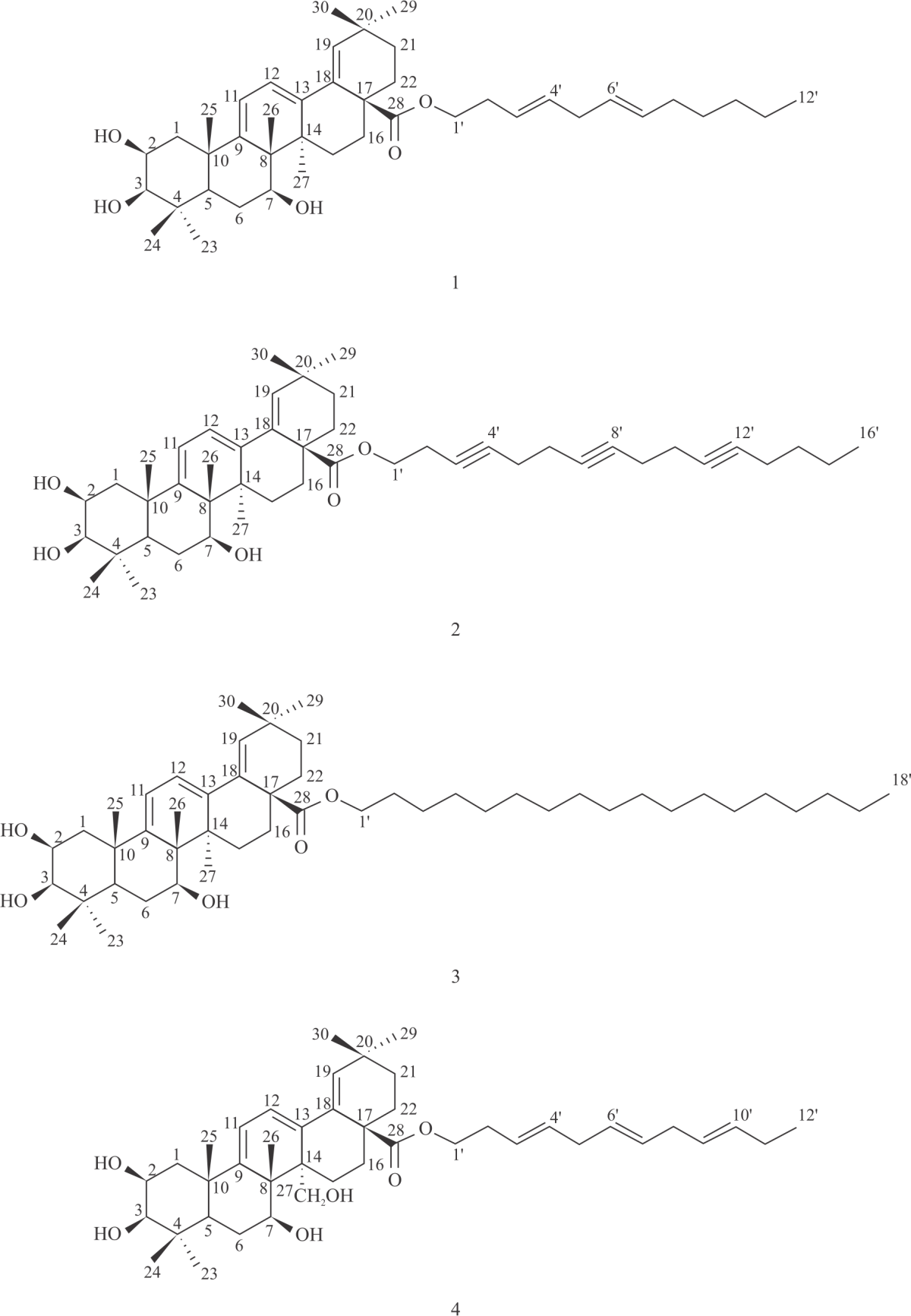Preparative Isolation of Glucosidase Inhibiting Compounds from Olea europaea Leaves
Background and Aim: Olea europaea L. (Oleaceae) has worldwide reputation for its medicinal properties. In
Mediterranean region its health benefits are considered so great that it is used regularly as preventive medicine. A
decoction of olive leaf is said to have a hypoglycemic effect. Our aim was to provide scientific evidence to back up this
belief.
Methods: The ethanolic extract of leaves of O. europaea was fractionated with hexane and ethyl acetate. The hexane
fraction was subjected to MPLC followed by preparatory TLC to isolate and purify compounds 1-4. The isolated
compounds were characterized using detailed spectroscopic analysis. In-vitro α-glucosidase inhibition assay was
carried out with the isolated compounds except 2. Compounds 1 and 3 were further tested for anti-hyperglycemic
activity in sucrose fed mice.
Results: Fractionation and chromatographic methods resulted in the isolation of four hydroxy oleanolic acid esters.
Their structures were deduced to be dodec-3, 6-dien-1-yl-2,3,7 trihdroxy-olean-9(11),12,18-trien-28-oate (1),
hexadec-3,7,11-triyn-1-yl-2,3,7-trihydroxy-olean-9(11),12,18-trien-28-oate (2), octadecan-1-yl-2,3,7-trihydroxyolean- 9 (11),12,18,trien-28-oate (3) and dodec-3, 6, 9-trien-1-yl-2,3,7,27-tetrahydroxy olean-9(11),12,18-trien-28-
oate (4). Compounds showed concentration dependent inhibition of α-glucosidase. Effective α-glucosidase
inhibition was achieved with compound 1 (IC50 50μg/ml), 3 (IC50 58 μg/ml), and 4 (IC50 65 μg/50 50 50 ml). In oral sucrose
tolerance test, compounds 1 and 3 showed 26.41% and 24.58% reduction in peak blood glucose level, respectively.
Conclusion: The isolated compounds were twice as potent as the extracts and fractions of O. europaea. It is clear that 2,
3-dihydroxy oleantrienoic acid moiety was important for the α-glucosidase inhibition of the compounds. Moreover, it
can be inferred that acetylation truncated the inhibitory activity (as of 4) while as the esterification with long chain
alcohols improved the action of compounds (as shown by 1 and 3 versus oleanolic acid acetate). The results
highlighted the significance of systematic study of traditional drugs to support their claims and wider global
acceptability.
 |
| Fig. 1: | Showing chemical structures of isolated compounds from Olea europaea |
How to Cite this paper?
APA-7 Style
H Alkefai,
N., R Mir,
S. (2022). Preparative Isolation of Glucosidase Inhibiting Compounds from Olea europaea Leaves. Research Journal of Phytochemistry, 16(1), 29-30. https://rjp.scione.com/cms/abstract.php?id=37
ACS Style
H Alkefai,
N.; R Mir,
S. Preparative Isolation of Glucosidase Inhibiting Compounds from Olea europaea Leaves. Res. J. Phytochem 2022, 16, 29-30. https://rjp.scione.com/cms/abstract.php?id=37
AMA Style
H Alkefai
N, R Mir
S. Preparative Isolation of Glucosidase Inhibiting Compounds from Olea europaea Leaves. Research Journal of Phytochemistry. 2022; 16(1): 29-30. https://rjp.scione.com/cms/abstract.php?id=37
Chicago/Turabian Style
H Alkefai, Naila, and Showkat R Mir.
2022. "Preparative Isolation of Glucosidase Inhibiting Compounds from Olea europaea Leaves" Research Journal of Phytochemistry 16, no. 1: 29-30. https://rjp.scione.com/cms/abstract.php?id=37

This work is licensed under a Creative Commons Attribution 4.0 International License.



